Intel's Pentium M on the Desktop - A Viable Alternative?
by Anand Lal Shimpi on February 7, 2005 4:00 PM EST- Posted in
- CPUs
Business/General Use Performance
Business Winstone 2004
Business Winstone 2004 tests the following applications in various usage scenarios:- Microsoft Access 2002
- Microsoft Excel 2002
- Microsoft FrontPage 2002
- Microsoft Outlook 2002
- Microsoft PowerPoint 2002
- Microsoft Project 2002
- Microsoft Word 2002
- Norton AntiVirus Professional Edition 2003
- WinZip 8.1

In business applications, the Pentium M does extremely well - with the 755 offering performance equivalent to that of an Athlon 64 FX-55. This is undoubtedly due to the extremely low latency L2 cache, which matters considerably in business applications.
Office Productivity SYSMark 2004
SYSMark's Office Productivity suite consists of three tests, the first of which is the Communication test. The Communication test consists of the following:"The user receives an email in Outlook 2002 that contains a collection of documents in a zip file. The user reviews his email and updates his calendar while VirusScan 7.0 scans the system. The corporate web site is viewed in Internet Explorer 6.0. Finally, Internet Explorer is used to look at samples of the web pages and documents created during the scenario."
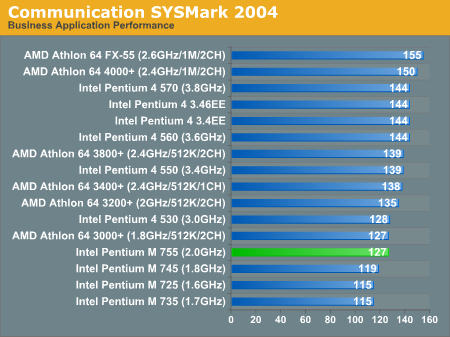
Immediately, we see that the Pentium M can't always do well, as even the 2.0GHz Pentium M 755 can't outperform the Athlon 64 3000+. The communication suite stresses memory bandwidth and latency rather than applications and usage patterns that fit into cache, so the Pentium M loses out big time.
The next test is Document Creation performance, which shows very little difference in drive performance between the contenders:
"The user edits the document using Word 2002. He transcribes an audio file into a document using Dragon NaturallySpeaking 6. Once the document has all the necessary pieces in place, the user changes it into a portable format for easy and secure distribution using Acrobat 5.0.5. The user creates a marketing presentation in PowerPoint 2002 and adds elements to a slide show template."
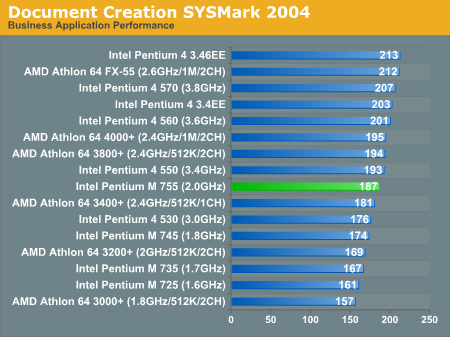
The Pentium M does a bit better in the document creation tests, as they are mostly using applications that will fit within the CPU's cache. However, the introduction of a voice recognition program into the test stresses the Pentium M's floating point performance, which does hamper its abilities here.
The final test in our Office Productivity suite is Data Analysis, which BAPCo describes as:
"The user opens a database using Access 2002 and runs some queries. A collection of documents are archived using WinZip 8.1. The queries' results are imported into a spreadsheet using Excel 2002 and are used to generate graphical charts."
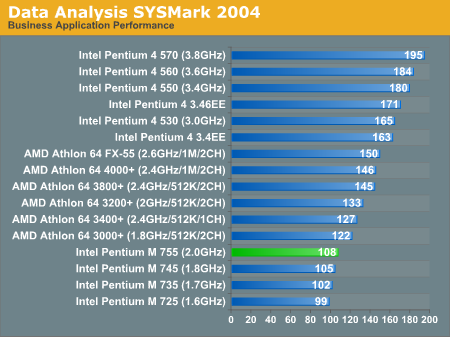
Without a doubt, the inclusion of Access usage patterns in the data analysis suite kills the Pentium M's chances here, as it once again brings up the tail in performance.
Microsoft Office XP SP-2
Here, we see in that the purest of office application tests, performance doesn't vary all too much.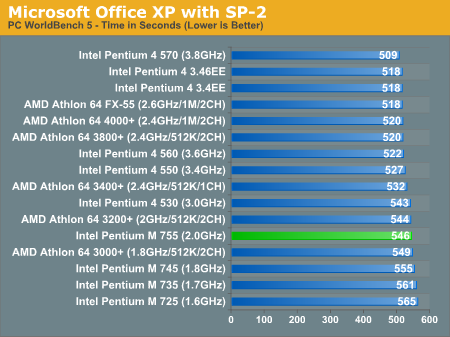
The Pentium M is competitive here, but so are all of the other CPUs.
Mozilla 1.4
Quite possibly the most frequently used application on any desktop is the one that we pay the least amount of attention when it comes to performance. While a bit older than the core that is now used in Firefox, performance in Mozilla is worth looking at as many users are switching from IE to a much more capable browser on the PC - Firefox.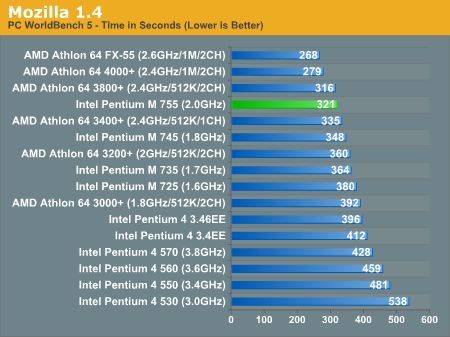
The Pentium M does extremely well here, outperforming both Athlon 64 and Pentium 4 competitors. Only the higher clock speed of the Athlon 64 gives it the overall lead here.
ACD Systems ACDSee PowerPack 5.0
ACDSee is a popular image editing tool that is great for basic image editing options such as batch resizing, rotating, cropping and other such features that are too elementary to justify purchasing something as powerful as Photoshop. There are no extremely complex filters here, just pure batch image processing.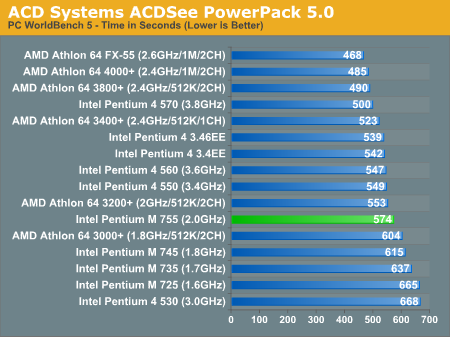
Once again, we see the Pentium M bring up the rear in situations where its low latency L2 cache can't help it.
Winzip
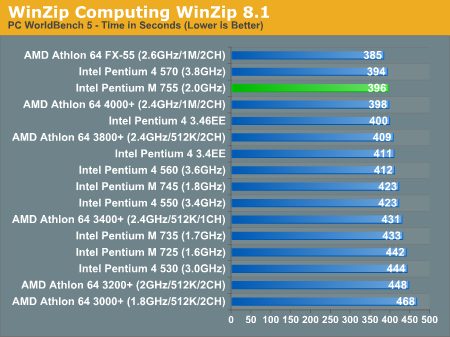
The Pentium M is fairly competitive in the real-world WinZip test - coming in third place overall, but the margin of victory isn't too great.
Let's look at how its peak theoretical performance is under WinRAR's built in benchmark:
WinRAR 3.40
Pulling the hard disk out of the equation, we can get a much better idea of which processors are truly best suited for file compression.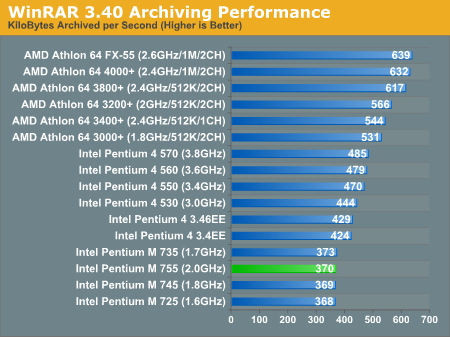
Here, we see that the lack of memory bandwidth really hurts the performance potential of the Pentium M. Luckily, most archiving tasks are usually disk-limited, so the performance differential won't be this bad in reality.










77 Comments
View All Comments
bobsmith1492 - Monday, February 7, 2005 - link
Granted the T8000 here is an Intel fanboy, but please notice Anand was comparing clock-for-clock.T8000 - Monday, February 7, 2005 - link
There is one big difference between this review and the reviews where the Pentium M did very well: CLOCKSPEED!While others where able to get over 2.8 Ghz with aircooling, Anand got just 2.4 Ghz. This may be a coincidence, but it is the difference between surprisingly good performance and a few % below others.
As most of the benchmarks where based on the stock 2 Ghz, the difference became even greater.
So this review just shows that the stock speed Pentium M performs about 30% less with about 30% less clockspeed than overclocked versions.
A slightly redesigned version with higher voltages is not extremely unlikely to hit at least 3 Ghz. Combining that with a desktop chipset will result in stellar performance, as the benchmark scores in this review (x1.5) indicate.
But since there is no slightly redesigned version and Intel has no good reason to make one, the current Pentium M desktops will only appeal to overclockers and silent computing people.
Also, for some reason, Anand found the 90W TDP of the 2.4 Ghz A64 closer to the 20W of the P-M than to the 110W of the 3.8 Ghz P4.
CSMR - Monday, February 7, 2005 - link
That's a very good option Zebo, thanks for posting it.teutonicknight - Monday, February 7, 2005 - link
One suggestion: Why don't you start using a newer version of Premiere for testing? I personally don't use it, but every that I know who does says before Premiere Pro, the program sucked. I'm sure the render results would be much more realistic and accurate if you used a more up to date version of the programRegs - Monday, February 7, 2005 - link
I was wondering the same thing too Jeff. If you feed it more bandwidth, it would eliminate the pipeline stalls and maybe give it a chance to reach higher clock speeds. Right? Or is it still prohibited by the shorter pipeline to reach higher clock speeds?Longer pipeline = wasted clock cycles. But to me that sounds like the PM should actually scale a lot better with a speed boost. Why exactly does it scale badly compared to a P4? Could it be remedied in anyway with a dual channel memory bus?
ozzimark - Monday, February 7, 2005 - link
there's something wrong with the 3400+ in the spec tests. why is the 3000+ beating it consitantly?Warder45 - Monday, February 7, 2005 - link
Maybe I missed something but I don't see the reason for all the negitivity in the final words. The 2.4Ghz P-M was very close to the A64 2.4Ghz in many of the tests, 3D rendering seemed to slow it down but that looked like it. With better boards and memory the P-M might best the A64 in a clock for clock match up.I do agree the prices are way too high. I think Intel really needs to wake up and smell what they have cooking here. With more support and more aggressive priceing they could easily have a winner in the HTPC and SFF markets.
plewis00 - Monday, February 7, 2005 - link
Surely when someone builds a mainboard with the Sonoma (i915) platform using PCI-E and DDR2-533 then it will change. And I wouldn't have thought that's that far off assuming they don't charge rip-off prices for the technology. It would also be perfect for Shuttle systems where the emphasis is on quietness and coolness rather than so much on performance.Zebo - Monday, February 7, 2005 - link
CSMRSo's this one very soon..
http://www.xtremesystems.org/forums/showthread.php...
...more than excellent performance wise if Dothan is excellent...power differential hopefully for AMD will be nominal.
Sokaku - Monday, February 7, 2005 - link
While it is true that the A64 has way more bandwidth, I doubt that is the reason why it crushed the P-M in the Professional Applications. I think the real cause is to be found in the P-M's abillity to do FP divisions. The P-III had a pipelined FP unit, however div operations were extremly expensive. My guess would be that Intel haven't thrown much effort into improving on this.